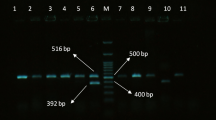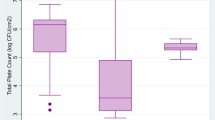Abstract
The aim of this study was to find the prevalence of β-haemolytic Escherichia coli in milk, as well as their sources, and their sensitivity to antibiotics. E. coli was isolated from samples of cow and camel milk, cow and camel udder surfaces, and milking persons’ hands. The organisms were identified using API20E biochemical kit. Haemolytic activity was tested on 7% defibrinated sheep blood agar while antibiotic sensitivity was tested using the Kirby-Bauer disc diffusion method. The prevalence of β-haemolytic isolates from cow and camel milk was 25% and 32% respectively. None of the isolates from the udder swabs, the milking persons’ hands, or water was β-haemolytic. In cow milk, the prevalence of isolates resistant to Ampicillin, Cefotaxime, and Cefepime was 25, 37.5 and 12.5% respectively, while in camel milk it was 52.4, 23.8 and 28.6% respectively. Prevalence of β-haemolytic and multidrug resistant isolates to the three antibiotics was 12.5% for cow milk and 19% for camel milk. None of the isolates was resistant to Ciprofloxacin, Piperacillin/Tozobactam, Amikacin, and Imipenem. The prevalence of E. coli resistant to Cefotaxime and Cefepime indicates growing resistance of the microorganisms to drugs that are supposed to be effective against them. The presence of β-haemolytic isolates in milk and their absence on the animals’ udder surface and hand swabs could indicate their better survival in the udder from which they are shed into the milk. This is a public health concern especially for pastoral communities who have a preference for consumption of raw milk.


Similar content being viewed by others
References
Abdelgadir AE (2014) Mastitis in camels (Camelus dromedaries): past and recent research in pastoral production system of both East Africa and Middle East. J Vet Med Anim Health 6(7):208–216
Adefurin A, Jacqz-Aigrain E, Choonara I (2011) Ciprofloxacin safety in paedriatics: a systematic review. Arch Dis Child 96(9):874–880
Ahmed AM, Shimamoto T (2011) Molecular characterization of antimicrobial resistance in Gram-negative bacteria isolated from bovine mastitis in Egypt. Microbiol Immunol 55:318–327
Bauer AW, Kirby WM, Sherris JC, Turk M (1966) Antibiotic susceptibility testing by a standardized single disk method. Am J Clin Pathol 45(4):493–496
Baylis C, Uyttendaele M, Joosten H, Davies A (2011) The Enterobacteriaceae and their significance to the food industry. A report commissioned by the ILSI Europe emerging microbiological issues task force. International Life Sciences Institute. http://ilsi.eu/wp-content/uploads/sites/3/2016/06/EP-Enterobacteriaceae.pdf. Accessed 20 Apr 2014
Brinas L, Lantero M, Diego I, Alvarez M, Zarazaga M, Torres C (2005) Mechanisms of resistance to expanded-spectrum cephalosporins in Escherichia coli isolates recovered in a Spanish hospital. J Antimicrob Chemother 56:1107–1110
CDC (Center for Disease Control of the United States of America) (2013) Antibiotic resistance threats in the United States, 2013. US Department of Health and Human Services. www.cdc.gov. Accessed 10 July 2017
China B, Goffaux F (1999) Secretion of virulence factors by Escherichia coli. BMC Vet Res 30(2–3):181–202
Chong Y, Yakushiji H, Ito Y, Kamimura T (2009) Cefepime-resistant gram-negative bacteremia in febrile neutropenic patients with hematological malignancies. Int J Infect Dis 14s:e171–e175
CLSI (2016) Performance standards for antimicrobial susceptibility testing. 26th edition. CLSI supplement M100S. Clinical Laboratory Standards Institute, Wayne, PA. http://ljzx.cqrmhospital.com/upfiles/201601/20160112155335884.pdf. Accessed 13 Dec 2017
Davies MA, Sischo WM, Jones LP, Moore DA, Ahmed S, Short DM, Besser TE (2015) Recent emergence of Escherichia coli with cephalosporin resistance conferred by bla CTX-M on Washington State dairy farms. Appl Environ Microbial 81:4403–4410
El-Ziney MG, Al-Turki AI (2008) Microbiological quality and safety assessment of camel milk (Camelus dromedaries) in Saudi Arabia (Qassim region). Appl Ecol Env Res 5(2):112–115
FAO (2011) Global food losses and food waste. Extent, causes and prevention. International Congress “Save Food”, Düsseldorf, Germany. http://www.fao.org/docrep/014/mb060e/mb060e00.pdf. Accessed 21 Jun 2017
Fernandes R (2008) Microbiology handbook: dairy products. Leatherhead Publishing, Leatherhead
GARP (Global Antibiotic Resistance Working Partnership)—Kenya Working Group (2011) Situation analysis and recommendations: antibiotic use and resistance in Kenya: Washington DC, and New Delhi: Center for Disease Dynamics, Economics and Policy. https://cddep.org/wp-content/uploads/2017/08/garp-kenya_es.pdf. Accessed 21 Apr 2014
GOK (Government of Kenya) (2010) Kenya dairy master plan. Ministry of livestock development, Nairobi, Kenya. https://kdb.co.ke/press/publications/reports/5-kenya-national-dairy-master-plan/file. Accessed 12 Apr 2014
GOK (Government of Kenya) (2016) Kenya essentials medicines list 2016. Ministry of health http://apps.who.int/medicinedocs/documents/s23035en/s23035en.pdf. Accessed 23 Aug 2018
Harel J, Martin C (1999) Virulence gene regulation in pathogenic E. coli. BMC Vet Res 30(2–3):131–151
Iyer PA, Albaik M, Baghallab I (2014) Mastitis in camels in African and Middle East countries. J Bacteriol Parasitol 5:3
Jay JM, Losssner MJ, Golden AG (2005) Modern food microbiology. Springer Science + Business Media Inc, New York
Kaindi DW, Schelling E, Wangoh JM, Imungi JK, Farah Z, Meille L (2011) Risk factors for symptoms of gastrointestinal illness in rural town Isiolo, Kenya. Zoonoses Public Health 59(2):118–125
Khan MZ, Khan A (2006) Basic facts of mastitis in dairy animals: a review. Pakistan Vet J 26(4):204–208
Kukanur S, Meundi M, Bajaj A, Kotigadde S (2015) Co-relation between virulence factors and antibiotic resistance of E. coli, with special reference to uropathogenic E. coli. IOSR-JDMS 14(3):15–21
Lamuka OP, Njeruh FM, Gitao GC, Abey KA (2017) Camel health management and pastoralists’ knowledge and information on zoonoses and food safety risks in Isiolo County, Kenya. Pastoralism 7:20
Nato SM, Matofari JW, Bebe BO, Huelsebusch C (2018) Effect of predisposing factors on microbial loads in camel milk along the pastoral dairy value chain in Kenya. Pastoralism 8:16
Naveen R, Mathai P (2005) Some virulence characteristics of uropathogenic E. coli in different patient groups. Indian J Med Res 122(2):143–147
Neto JN, Silva LD, Martins AC, Tiraboschi RB, Domingos AL, Suaid HJ, Tucci S, Cologna AJ (2003) Prevalence and susceptibility of hospital acquired urinary tract information. Acta Bras Cir 18(Suppl 5):36–38
Nogueria KS, Daur AV, Reason IT, Gales AC, Costa LM (2011) Cefepime versus extended spectrum β-lactamase-producing Enterobacteriaceae. Braz J Infect Dis 15(2):167–169
Noor IM, Guliye AY, Tariq M, Bebe BO (2013) Assessment of camel and camel milk marketing practices in an emerging peri-urban production system in Isiolo County, Kenya. Pastoralism 3:28
Patel T, Levitin A (2014) Escherichia coli adaptive resistance to clinical antibiotics. JSM Microbiol 2(1):1007
Paterson DL, Bonomo RA (2005) Extended-spectrum β-lactamases: a clinical Update. Clin Microbiol Rev 18(4):657–686
Shaikh S, Fatima J, Shakil S, Mohd S, Rizvi D, Kamal MA (2015) Antibiotic resistance and extended spectrum beta-lactamases: types, epidemiology and treatment. Saudi J Biol Sci 22:90–101
Short EC, Kurtz HZ (1971) Properties of haemolytic activity of Escherichia coli. Infect Immun 3(5):678–687
Tamma PD, Cosgrove SE, Maragakis LL (2012) Combination therapy for treatment of infections for gram-negative bacteria. Clin Microbiol Rev 25(3):450–470
Vincent CP, Boerlin P, Daignault D, Dozois CM, Dutil L, Galanakis C, Reid-Smith RJ, Tellier PP, Teliss PA, Ziebell TK, Manges AR (2010) Food reservoir for Escherichia coli causing urinary tract infections. Emerg Infect Dis 16(1):88–95
Wanjohi MC, Gitao G, Bebora L (2013) Subclinical mastitis affecting hygienic quality of marketed milk from North-Eastern Province, Kenya. Microbiol Res Int 1(1):6–15
Wiedemann B, Heisg A, Heisg P (2014) Uncomplicated urinary tract infections and antibiotic resistance—epidemiological and mechanistic aspects. J Antibiot 3:341–352
Acknowledgements
The study was facilitated by the RELOAD project with funding from the German Ministry of Education and Research (BMBF) within the framework of GlobE initiative, Grant no. 031A247A-D. The authors wish to thank Isiolo referral hospital and University of Nairobi for allowing them to use their microbiology laboratories. The authors wish to thank Ms Bernadette Misiko, Ms Ruth Imbahale, and Mr James Mwangi for their assistance in laboratory work. Special recognition is accorded to Mr Peter Lamuka (deceased), formally of University of Nairobi for the inspiration, encouragement and advice during the course of the study.
Author information
Authors and Affiliations
Corresponding author
Ethics declarations
Conflict of interest
The authors declare that they have no conflict of interest.
Rights and permissions
About this article
Cite this article
Nato, S.M., Matofari, J.W., Bebe, B.O. et al. Prevalence of β-haemolytic multi-drug resistant E. coli in cow and camel milk in Kenya. J Consum Prot Food Saf 14, 55–61 (2019). https://doi.org/10.1007/s00003-018-1187-4
Received:
Revised:
Accepted:
Published:
Issue Date:
DOI: https://doi.org/10.1007/s00003-018-1187-4




